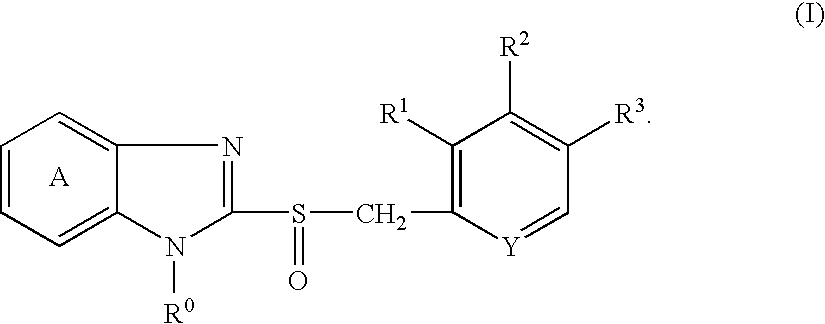Method for Producing Granules
a technology of granules and fine granules, which is applied in the direction of colloidal chemistry, biocide, drug compositions, etc., can solve the problems of difficult to stably obtain a granule or fine granule preparation having a desirable dissolution profile required for producing a desirable effect, and achieves the effect of reducing variation in the dissolution profile, facilitating stably maintaining an effective blood concentration of a drug, and improving the dissolution variation
- Summary
- Abstract
- Description
- Claims
- Application Information
AI Technical Summary
Benefits of technology
Problems solved by technology
Method used
Image
Examples
example 1
[0395]Composition is Shown in Table 1. (R)-Lansoprazole (7,290 g), magnesium carbonate (1,944 g), sucrose (roughly ground, 4,820 g) and low substituted hydroxypropyl cellulose (1,458 g) were mixed using a vertical granulator to prepare a spraying or dusting material containing an active pharmaceutical ingredient (15,494 g in total). Sucrose-corn starch spherical granules (4,500 g; NONPAREIL 101-750, manufactured by Freund Co.) were put in a centrifugal fluidized bed granulator (CF-600S, manufactured by Freund Co.) as cores, and then sprayed or dusted with the spraying or dusting material containing an active pharmaceutical ingredient (14,346 g) while being sprayed with a solution of hydroxypropyl cellulose (2% aqueous solution: W / W) (final spray amount: 54 g (solid matter)) to obtain spherical granules. The coating was performed under the conditions of rotor speed: 160 rpm, linear velocity: 339 m / mm, and spraying or dusting speed of the active pharmaceutical ingredient per 1 g of th...
experimental example 1
[0398]The intermediate layer granules A, A-5, A-10 and A-15 obtained in Example 1 were tested for dissolution property in a phosphate buffer (pH 6.8). Table 2 shows the proportion of the amount of an active ingredient dissolved after 20 minutes to the total amount (content) of the active ingredient contained in the intermediate layer granule, that is, dissolution rate (%).
TABLE 2TimeDissolution rate (%)(minutes)AA-5A-10A-152068.3100.297.2103.4
[0399]While the intermediate layer granule A, which was untreated, showed a dissolution rate after 20 minutes of about 70%, all the intermediate layer granules A-5, A-10 and A-15, which were subjected to heat treatment, showed a dissolution rate of almost 100%.
example 2
[0400]Composition is shown in Table 3. The intermediate layer granules A obtained in Example 1 were put in a fluidized bed granulation coating machine (MP-10, manufactured by POWREX Co.) and then heated at 70° C. for 5 minutes. Subsequently, the granules were coated with a coating liquid for forming a pH-dependent soluble controlled-release film. The spherical granules thus obtained were dried in vacuum at 40° C. for 16 hours and sieved with a round sieve to obtain pH-dependent soluble controlled-release granules A with a particle size of 1,000 μm to 1,700 μm.
TABLE 3Controlled-Release Coating Film>Methacrylic Acid Copolymer (Type B)47.85mgMethacrylic Acid Copolymer (Type A)15.96mgTriethyl Citrate6.36mgTalc31.89mgEthanol826.69mgPurified Water91.85mgTotal (Solid matter)102.06mgGranule A>Intermediate Layer Granule A212.64mgCoating Liquid for pH-Dependent Soluble102.06mgControlled-Release Coating FilmTotal314.7mg
PUM
| Property | Measurement | Unit |
|---|---|---|
| Temperature | aaaaa | aaaaa |
| Temperature | aaaaa | aaaaa |
| Temperature | aaaaa | aaaaa |
Abstract
Description
Claims
Application Information
 Login to View More
Login to View More - R&D
- Intellectual Property
- Life Sciences
- Materials
- Tech Scout
- Unparalleled Data Quality
- Higher Quality Content
- 60% Fewer Hallucinations
Browse by: Latest US Patents, China's latest patents, Technical Efficacy Thesaurus, Application Domain, Technology Topic, Popular Technical Reports.
© 2025 PatSnap. All rights reserved.Legal|Privacy policy|Modern Slavery Act Transparency Statement|Sitemap|About US| Contact US: help@patsnap.com



